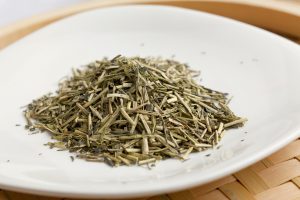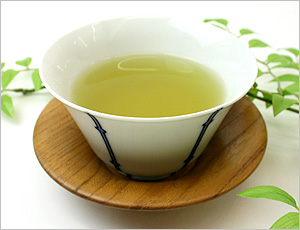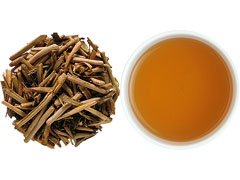 Kukicha (茎茶, twig tea) is special because unlike most teas it isn’t made with tea leaves, but twigs and stems instead.
Kukicha (茎茶, twig tea) is special because unlike most teas it isn’t made with tea leaves, but twigs and stems instead.
When tea leaves are harvested, they go through a selection process where stems and twigs are separated from the leaves. Nowadays this is usually done by a machine.
Kukicha is slightly sweet. The aroma is quite unique when compared with other Japanese green teas. I don’t know how to describe its particular smell, but you’ll notice the difference immediately.
Other names of kukicha
 In kyoto it is called karigane (雁が音, wild goose) and it normally means that it’s made from the twigs and stems of gyokuro and high-grade sencha.
In kyoto it is called karigane (雁が音, wild goose) and it normally means that it’s made from the twigs and stems of gyokuro and high-grade sencha.
Obviously, kukicha made from gyukuro is the best kukicha in terms of quality. A kukicha made from bancha will be a very low quality tea, so be careful when shopping.
Why the name karigane, which means wild goose? Apparently, wild geese rest on branches floating in the sea during their migration.
I’m not sure if this is a fact but it sounds very poetic, don’t you think?
In other parts of Japan kukicha is also called shiraore (白折, white fold) or boucha (棒茶, stick tea).
Kaga boucha
 Kaga boucha (加賀棒茶, kaga stick tea) or houji boucha (ほうじ棒茶, roasted stick tea) is popular in Ishikawa prefecture (especially Kaga city) and it is roasted kukicha.
Kaga boucha (加賀棒茶, kaga stick tea) or houji boucha (ほうじ棒茶, roasted stick tea) is popular in Ishikawa prefecture (especially Kaga city) and it is roasted kukicha.
As you can see in the picture, the small stems and twigs have a brown color similar to houjicha.
Perhaps I should have given kaga boucha its own page, but because it isn’t as widely known as kukicha I decided to join both of them.
Kaga boucha has a roasted smell and flavor, very little astringency and bitterness. Just like houjicha, it is low in caffeine and catechin because of the roasting process.
Did you know that you can make your own kaga boucha at home?
Compounds in kukicha
Kukicha is sweet because it is high in L-theanine. The reason for this is that L-theanine is naturally produced in the roots, and from there it’s sent to the leaves via the stem.
The leaves produce catechins but lose L-theanine through photosynthesis. Since gyokuro is shaded to avoid this loss, the L-theanine content is even higher in kukicha made from gyokuro.
High L-theanine content and low caffeine results in a sweet flavor with very little bitterness.
How to brew kukicha
The brewing process is almost the same as in sencha. 1 tsp of kukicha (4 gr) per cup (60 ml, 2 oz), 80 °C (176 °F) for 1 minute.
Add the kukicha into your kyusu (Japanese tea pot). Then boil the water, and pour it into the cups to warm then up. Immediately pour the water from the cups into your kyusu (Japanese tea pot). The water temperature should now be about 80 °C.
Let brew for 1 minute, and serve by alternating from cup to cup. Don’t pour all the tea into one cup and then the other, because the second cup will be more concentrated that the first one.

April 19, 2014
Hey, thanks for the article!
I was really confused about the way of preparing kukicha. The instructions on the internet a very confusing, and I even read that it should be simmered in hot water for 5-6 (minutes? Seconds? no idea, it just said 5-6).
Would be a pity to ruin a good tea.
April 19, 2014
Hello Enric.
Thanks for your comment.
5 minutes is too long for any Japanese green tea, but it may be suitable for a black tea. Maybe there was some kind of mistake there.
Anyway, brew according to your taste! Guidelines are there just to get you started.
June 29, 2014
Thanks for the nice article, Ricardo!
Enric, you are most probably refering to roasted kukicha or hoji-kukicha. This kind of tea is very popular in macrobiotic circles and is known there simply as kukicha. Can be a bit confusing as this isn’t the most accurate way of refering to it.
You are right. Roasted kukicha is usually brewed by simmering. Most common brewing time seems to be 5 minutes. But I’ve heard stories about some people brewing it for 10 or even 20 minutes. As with all teas, it’s a matter of personal taste.
June 29, 2014
Hi Javier
Thanks for your comment. I didn’t know about the roasted kukicha being called kukicha in the macrobiotic diet.
April 2, 2019
Hi , I like my twig tea with a few teaspoons of chai seasons brewed with twigs. They really go well together.
February 14, 2015
Hello I drank some kukicha here in Denmark and i waited 3 min. It tasted really good now your telling me that i should wait 1 min…
If i brew it for 3 min can i brew another one with the same tea in the pot (if it’s completely empty of water)
Or i have read some different information about this.
February 14, 2015
Sorry for another reply but on a different site it says 2 tablespoon is 6-8 grams. Here it says 1 teaspoon is 4 grams. i better measure and see.
February 14, 2015
Hello Niklas
I’m giving you the general guidelines as in Japan. But they are just guidelines, you are free to brew as you wish.
Yes, you can make another infusion of kukicha with the same leaves, and may even go for a third one depending on your tea to water ratio.
You didn’t tell me the water volume that you’re using. That’s very important as well.
Regarding the teaspoons, the best way is to use weight. The 4 grams per teaspoon is just an approximation.
September 24, 2015
Does anybody know the meaning of ‘white fold’? This is the translation of Shiraore but what is ‘white fold’ in reference to?
September 24, 2015
Thank you for your question Tom.
This answer was given to me by Kawamura san from http://www.kawamuraen.jp/
A long time ago there was no sencha and matcha was very precious.
The hard parts that couldn’t be ground in the stone mill to make matcha were called “oremono”, probably because they were so hard that you could make them snap. The common people would drink tea made from this undesirable parts.
Later on this turned into “shiraore”, because the stems and twigs are usually a much lighter color than the leaves, close to white.
July 31, 2016
Thank you for sharing the information in this article, short but straight to the point and cleared up a couple of questions 🙂
You see, I had just returned home from purchasing a small selection of new tea’s. One of which I assumed was Hojicha from the scent and appearance of the contents in the sample pot on display.
I must have just glanced at the label and not really paid attention to what it actually said haha.
When I returned home, I looked at the label and it says Kukicha. Now I don’t believe the shop actually has any Kukicha on sale and again, not paying much attention, I glanced at the sticker and thought it read Kokeicha at first, one that I already have purchased from their before (my heart skipped a beat or two when I thought I had picked up the wrong one, as Hojicha is one I havn’t yet had the pleasure of sampling and one I have wanted to for awhile now).
I opened the packet and in the end it was the correct tea, then I realised my mistake in misreading the print.
I have actually had the pleasure of owning 2 types of Kukicha, both being green in colour and both produced stunningly sweet, smooth liquors. The first was bought in France and was the standard type, the second I purchased directly from Japan and it was actually a Genmaicha that used Kukicha rather than the usual Bancha and I must say, it is by far the best Genmaicha I have ever tasted. When I first tried Genmaicha, my taste buds at the time found the toasted rice in the brew to be too ‘burnt’ tasting, but I have since come to love it over time, however, the Kukicha Genmaicha I now have is so much sweeter and I have often found myself disregarding others in my collection for this on many occasions (I did buy 1kg and Im so happy I did haha)
I have a quick question to ask with regards to the Kukicha Genmaicha, it is actually labelled as “Kuradashi” – Is there any chance you would be able to shine any light on what Kuradashi is?
I did a little research and what I found was that it is apparently stored and aged, not quite the same as Pu-Erh but what I read said it was similar and is aged for 6 months to alter the end resulting flavour characteristic of the leaves, some sources seemed to believe it was a good flavour enhancement method, whilst others said it is a bad practice and is used on poorer quality leaves, is there any truth in either of these statements?
After reading your article though, I now believe that the tea I have purchased isn’t Hojicha, nor the Kokicha they had it labelled as, but instead the Kaga Boucha you briefly touched upon in the middle of the article.
That said however, I am very pleased with it, second brew down and I must say it is absolutely delightful. I am a huge fan of those strong, sweet, roasted, savoury flavors. The tea actually tasted very similar to a yellow tea I had a long while ago. I had a friend bring it me when they moved back from uni and I dare say it was one of the best teas I had the pleasure of tasting, so much was my lust for it that the 50g I had barely lasted a couple of days and I have since not been able to find it since, as the shop is too far away from my location, they don’t do delivery/posting order and they simply just labelled it as “Huang Da Cha” (Yellow Mountain – if I am not mistaken) which after countless hours of researching I came to realise basically told me absolutely nothing haha.
The only other tea that came close, but had other much more complex characteristics to it was another I picked up in France called Cha Kio (I think it is classed as a Thailand grown green where I purchased it from).
This Kaga Boucha as you have clearly informed me of its by far a perfect replacement for both of the above mentioned and I must look into this one in more depth, so thank you so very much a million times over.
All the very best,
Josh
July 31, 2016
Dear Josh
Thanks for commenting.
Regarding your kuradashi question, it is said that aging mellows the taste of a green tea, so that it isn’t so vegetal.
Note that it is stored at a low temperature, so it will not go bad.
Basically, aging is done so that a specific tea is available all year round. I haven’t experienced trying the same tea with and without ageing, so I can’t tell you about the difference. But primarily it’s an issue of conservation.
October 13, 2017
I believe yellow mountain tea referred to is https://en.m.wikipedia.org/wiki/Huangshan_Maofeng
October 13, 2016
Hi Ricardo,
Thanks for the article 🙂 I was wondering, in order for me to get the maximum benefit of theanine, can I just grind Kukicha and drink the powder with hot water?
It’s gonna be first time for me to try japanese tea, including Kukicha…excited as I already love and drink usual green tea powder.
Let me know, thanks again!
October 13, 2016
Hi John
Thanks for your comment.
You can definitely do that.
There are also L-theanine supplements on the market, you could take a look at those too.
April 18, 2018
I know that Kaga Boucha is low in EGCG because it is roasted. But does it have a good level of l-theanine like the Kukicha?
April 18, 2018
Hi Patricia
Unfortunately, it also loses much of it as well when roasted.
https://www.myjapanesegreentea.com/analyzing-japanese-tea-nutrition-data